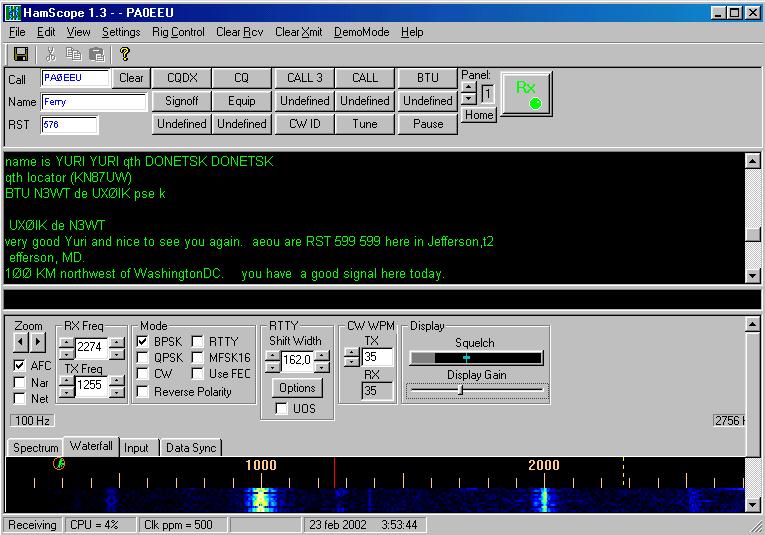
![]()
MFSK16
MFSK16 is a keyboard-to-keyboard "real time" mode, suitable for rag-chewing, nets and DX. Since the error correction is of the FEC type, it is also highly appropriate for bulletin broadcasts. Its technical superiority and ease of use should make it a natural replacement for RTTY, and should be considered for other rag-chew activity as well. Use MFSK when conditions are very changeable, the band is dying, or there is excessive ionospheric Doppler. Use MFSK on low bands when you want good copy despite very bad static and lightning noise. The technical designation of radio modes is defined by the CCIR, and nowhere more succinctly explained than in the FCC Part 47 Rules, paragraph 2.201. From this information we see that MFSK16 is a multi-frequency, single channel, FSK telegraphy transmission mode. The CCIR designation is therefore F1B (or F1D if transmitting non-text data). The definitions make no distinction between single-carrier and multi-carrier single channel systems, so MFSK and RTTY are equivalent. After all, RTTY is in reality 2FSK.
MFSK16 was designed to combat three problems - Ionospheric instability
and motion causing Doppler effects Ionospheric multi-path effects, causing timing problems
and fading Man-made electrical noise, lightning noise and QRM. The first of these,
"Doppler" is common on the high frequency bands on longer paths, especially
"long path" where the signal passes through the polar regions. Multi- path is common
on 20 metres, and can be severe on the lower bands. QRM is unfortunately with us everywhere,
while lightning and electrical noise are mostly a lower band (LF and 160 - 30m) problem.
Use MFSK16 for long path DX, polar HF paths, and when conditions are poor. If signals are
weak but stable, use PSK31! On lower bands, use MFSK16 at night, and PSK31 or PSK63F
during the day. If noise or QRM is the problem, use MFSK16. Copy is usually good in S9 noise
if the signal is above S6.
MFSK16 will be useful on LF due to the noise rejection properties. Although it is as sensitive
as PSK31, it offers no advantage on VHF where the ionosphere has little effect (but try MFSK16
on 6 metres).
Transmission Bandwidth
Necessary bandwidth is also defined by CCIR, and the process explained well in FCC Part 47,
paragraph 2.202. For a telegraph signal the necessary bandwidth is defined as:
BW = 2M + 2D.K Where M is the maximum modulating frequency and D is
the peak deviation. K is a factor related to the keying technique. K=1.2 for hard keyed FSK.
For an MFSK system this formula can be simplified to:
BW = B + m.s.K
where B is the baud rate, m is the number of tones, and s is the tone spacing. For example,
for a 16 tone, 15.625 baud system with 15.625 Hz tone spacing (the MFSK16 default mode), the
bandwidth is:
BW = B +m.s.K = 15.625 + 16 x 15.625 x 1.2 = 315.625 Hz.
Thus the overall designation of the default MFSK16 mode is 316HF1B.
As a comparison, 170 Hz shift 50 baud RTTY is 254HF1B. In practice most RTTY signals heard
on Amateur bands are rather wider than
this.
MFSK16 users subscribe to the MFSK Email Reflector, which you
can join by sending an email to MFSK-subscribe@egroups.com.
To meet Nino and Murray on air, try during weekends (Sat-Sun) in
Feld Hell mode, on 14062.5 KHz USB around 13:00 UTC, or
on MFSK week days on 18.106 MHz (idle carrier) at around 0530 or 1930 UTC.
The Stream Version 0.9 software can handle MFSK16 quite well. It can be downloaded from URL:
http://home.wanadoo.nl/nl9222/digisoft.htm
Another program that code and decode MFSK16 is Hamscope. The newer version
1.4 than shown hereunder can be downloaded from URL: http://www.qsl.net/hamscope/HamScope.html
This a screen display of Hamscope Version 1.3
The BPSK box is checked, meaning that the program is now working in the
PSK31
mode.
